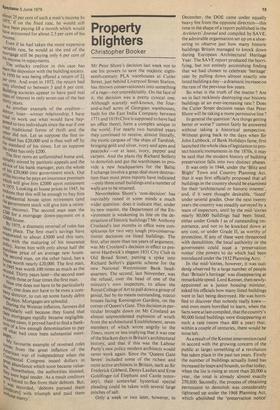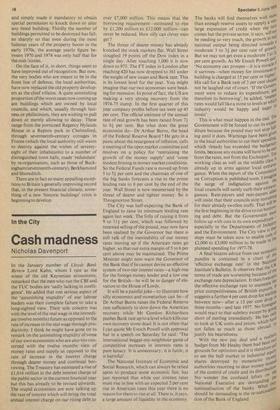Property blighters
Christopher Booker Mr Peter Shore's decision last week not to use his powers to save the majestic eighteenth-century PLA warehouses at Cutler Street, just behind Liverpool Street Station, has thrown conservationists into something of a rage—not unpredictably. On the face of it, the decision was a pretty cynical one. Although scarcely well-known, the fourand-a-half acres of Georgian warehouses, built for the East India Company between 1771 and 1819 (Clive is supposed to have had an office there), form a complex unique in the world. For nearly two hundred years they continued to receive, almost literally, the exotic cargoes of 'the ships of Tarshish, bringing gold and silver, ivory and apes and peacocks'—or at least, ivory, pepper and carpets. And the plans (by Richard Seifert) to demolish and gut the warehouses to provide a new headquarters for the Baltic Exchange involve a great deal more destruction than most press reports have indicated —only three small buildings and a number of walls are to be retained.
Nevertheless Shore's 'non-decision' has inevitably raised in some minds a much wider question : does it indicate that, under its new master, the Department of the Environment is weakening its line on the destruction of historic buildings? Mr Anthony Crosland's last months in office were conspicuous for two very tough pro-conservationist decisions on listed buildings. The first, after more than ten years of argument, was Mr Crosland's decision in effect to preserve Hardwick's elegant 1831 City Club in Old Broad Street, putting a spike into Richard Seifert's gigantic scheme for the new National Westminster Bank headquarters. The second, last November, was the refusal, over the head of one of the ministry's own inspectors, to allow the Royal College of Art to pull down a group of genial, but by no means outstanding, stucco houses facing Kensington Gardens, on the corner of Queen's Gate. This decision in particular brought down on Mr Crosland an almost unprecedented explosion of wrath from the architectural Establishment, seven members of which wrote angrily to the Times, more or less implying that it was one of the blackest days in Britain's architectural history, and that if this was the Labour Party's new policy modern architects would never work again. Since the 'Queens Gate Seven' included some of the richest and most active architects in Britain, such as Sir Frederick Gibberd, Denys Lasdun and Erne Goldfinger (of Elephant and Castle notoriety), their somewhat hysterical special pleading could be taken with several large pinches of salt.
Only a week or two later, however, in
December, the DOE came under equally heavy fire from the opposite direction—this time in the shape of a report published in the Architects' Journal and compiled by SAVE, the admirable organisation set up on a shoestring to observe just how many historic buildings Britain managed to knock down during European Architectural Heritage Year. The SAVE report produced the horrifying, but not entirely astonishing finding that we had chosen to celebrate 'heritage' year by pulling down almost exactly one listed building a day—a dramatic increase on the rate of the previous few years.
So what is the truth of the matter ? Are we in fact recklessly destroying our historic buildings at an ever-increasing rate? Does the Cutler Street decision mean that Peter Shore will be taking a more permissive line ?
In general the question 'Are things getting better or worse?' cannot fairly be answered without taking a historical perspective. Without going back to the days when Sir John Lubbock, of Bank Holidays fame, first launched the whole idea of legislation to protect historic monuments in the 1870s, it may be said that the modern history of building preservation falls into two distinct phases.
It was only in 1944, under the 'Blitz and Blight' Town and Country Planning Act, that it was first officially proposed that all buildings in the country should be examined for their 'architectural or historic interest', and, if it were thought desirable, 'listed' under several grades. Over the next twenty years the country was steadily surveyed by a team of inspectors, until by the mid-'sixties nearly 80,000 buildings had been listed, either under Grade I as of outstanding importance, and not to be knocked down at any cost, or under Grade II, as worthy of protection. If any of these were threatened with demolition, the local authority or the government could issue a 'preservation notice' (the powers to do which had been introduced under the 1932 Planning Act). '
In the mid-'sixties, however, it was suddenly observed by a large number of people that 'Britain's heritage' was disappearing at remarkable speed. Lord Kennet, then newlyappointed as a junior housing minister, asked his officials how many listed buildings were in fact being destroyed. He was horrified to discover that nobody really knew— and even more horrified to learn, when the facts were at last compiled, that the country's 80,000 listed buildings were disappearing at such a rate (more than 400 a year) that, within a couple of centuries, there would be none left.
As a result of the Kennet intervention (and in accord with the growing concern of the public at large) something of a revolution has taken place in the past ten years. Firstly the number of buildings actually listed has increased by leaps and bounds, so that today, when the list is rising at more than 20,000 a year, the total is already almost exactly 250,000. Secondly, the process of obtaining permission to demolish was considerably tightened up under the 1968 Planning Act, which abolished the 'preservation notice' and simply made it mandatory to obtain special permission to knock down or alter any listed building. Thirdly the number of buildings permitted to be destroyed has fallen sharply so that even during the most hideous years of the property boom in the early 1970s, the average yearly figure between 1970 and 1974 was only half that for -the mid-'sixties.
On the face of it, in short, things seem to have improved out of recognition. But now, the very bodies who are meant to be in the front line of defence, the local authorities, have now replaced the old property developers as the chief villains. A quite astonishing proportion of the worst cases now coming up are buildings which are owned by local councils, and which, usually through laziness or philistinism, they are wishing to pull down or merely allowing to decay. These range from the porticoed Regency Hylands House in a Repton park in Chelmsford, through seventeenth-century cottages in Frome (which the local authority still wants to destroy against the wishes of seventyeight of their inhabitants) to a number of distinguished town halls, made 'redundant' by re-organisation, such as those of Buckingham(seventeenth-century), Berkhamsted and Shoreditch.
There are in fact so many appalling exceptions to Britain's generally improving record that, in the present financial climate, something of a new 'historic buildings' crisis is beginning to develop.



































 Previous page
Previous page